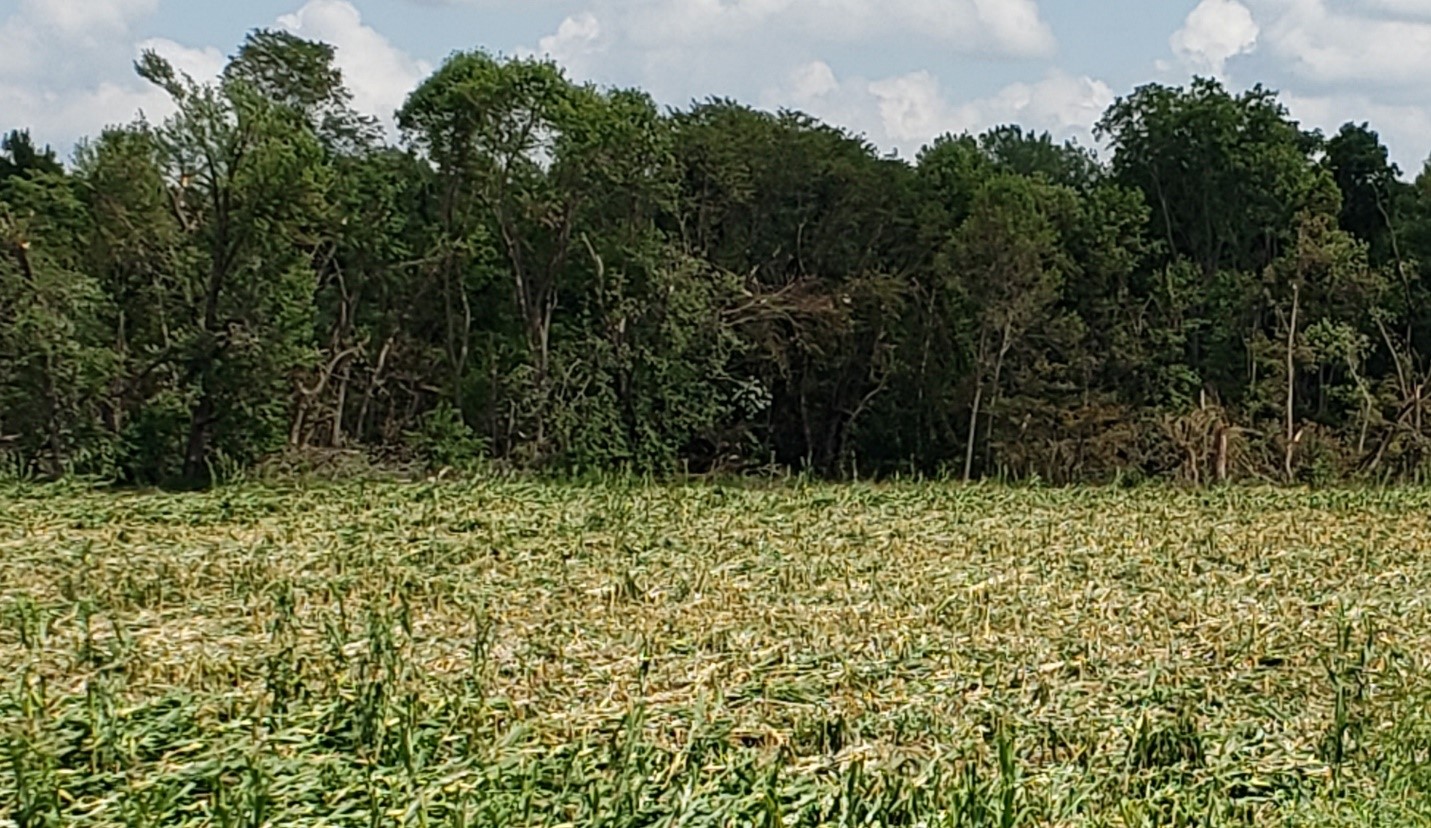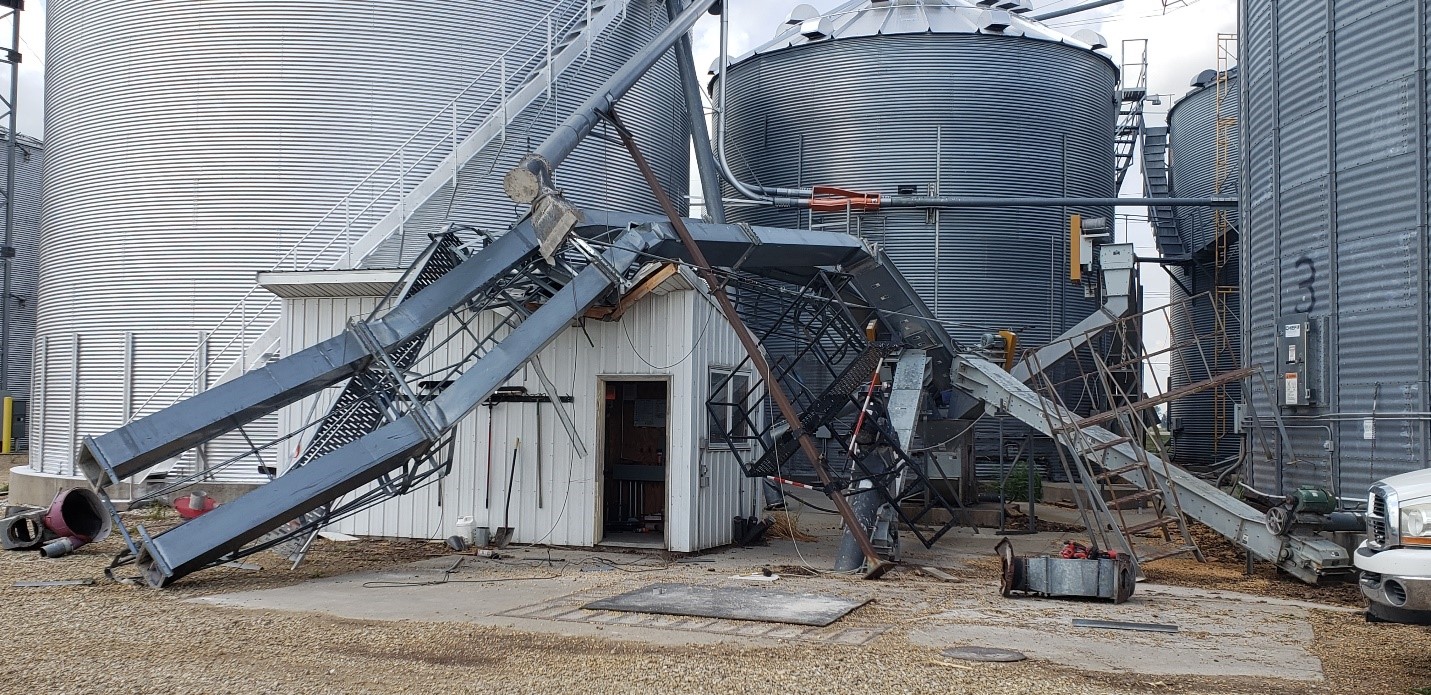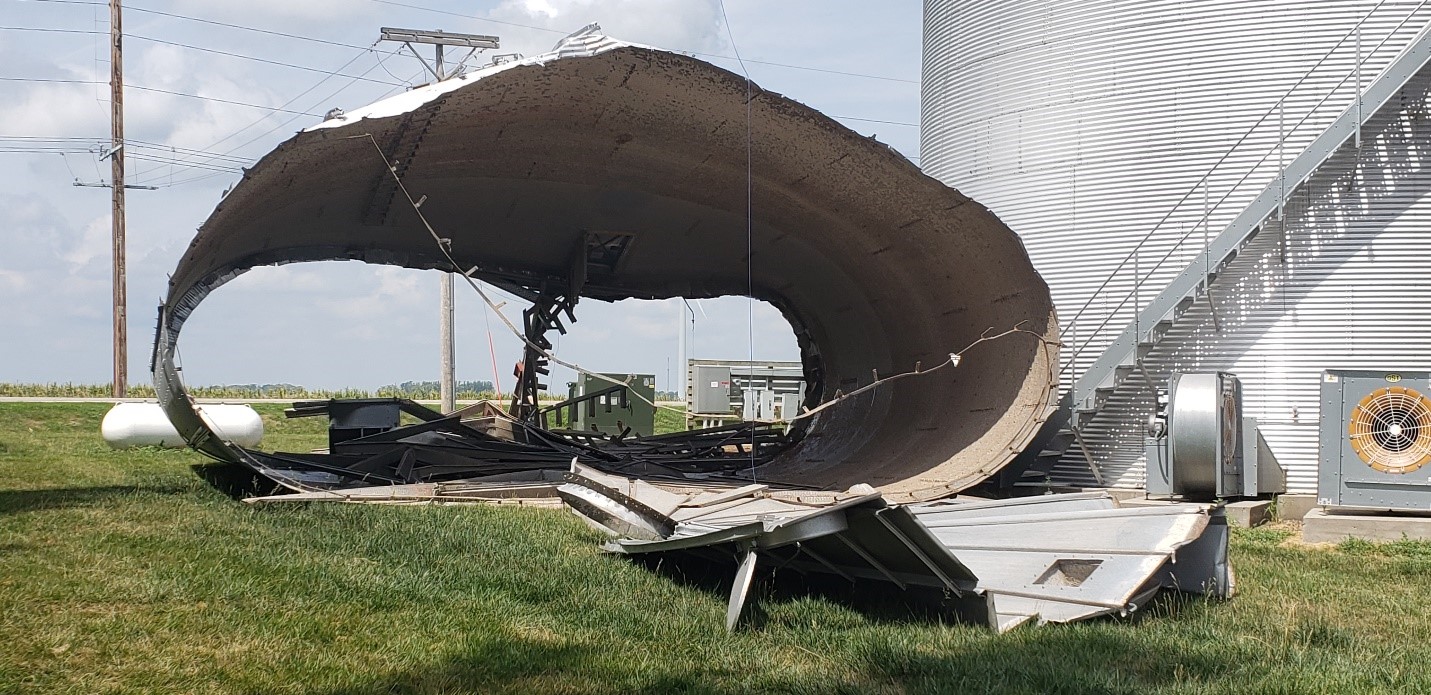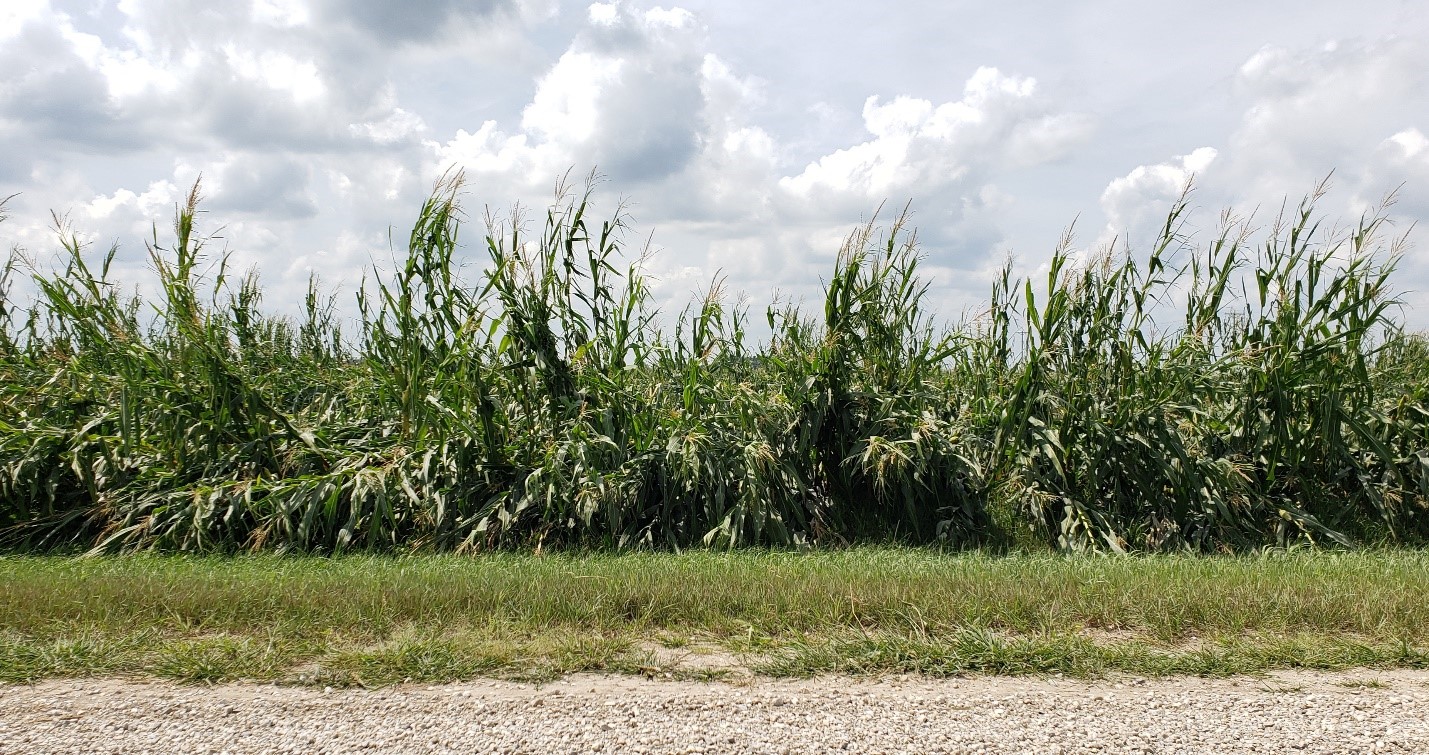 “The morning of August 10 in Iowa was hot and sticky,” reports Dustin Hoffmann (Iowa Agribusiness Radio Network, Des Moines, Iowa). “If you took two steps outside, it was no surprise that we had severe thunderstorm watches up already at 6 a.m. By 10:30 a.m., we had warnings going up around central Iowa. By 10:45 a.m., small hurricane-force winds started ripping through the state on the start of its 700-plus-mile trek across the Midwest.
“The morning of August 10 in Iowa was hot and sticky,” reports Dustin Hoffmann (Iowa Agribusiness Radio Network, Des Moines, Iowa). “If you took two steps outside, it was no surprise that we had severe thunderstorm watches up already at 6 a.m. By 10:30 a.m., we had warnings going up around central Iowa. By 10:45 a.m., small hurricane-force winds started ripping through the state on the start of its 700-plus-mile trek across the Midwest.
“The ‘derecho,’ as we have come to know it, flattened corn acres across Iowa. The soybeans faired a little better, and the worst reports we saw were of plants becoming entangled with each other. All in all, it is reported that the state had 14 million acres damaged. Corn damage was seen in more than eight million acres, and more than five-and-a-half million acres of soybeans were affected.
“Besides the loss to grain, we saw the devastation to grain storage. Parts of grain legs and pieces of grain bins were laying all over the fields and communities of rural Iowa. With harvest only days away, the loss of almost 57 million bushels of storage is going to put a strain on farmers, elevators, and the transportation network which moves grain around the country.
 “Rural communities also were severely affected. We have all heard the stories of Cedar Rapids, and our hearts go out to them. However, we cannot forget these small communities of less than 5,000 people. Agriculture is the backbone of their economies, and agriculture was just sucker-punched for the third time by Mother Nature in as many years. The people of Iowa remain resilient and determined to rise from the wind-fallen fields and shattered structures.”
“Rural communities also were severely affected. We have all heard the stories of Cedar Rapids, and our hearts go out to them. However, we cannot forget these small communities of less than 5,000 people. Agriculture is the backbone of their economies, and agriculture was just sucker-punched for the third time by Mother Nature in as many years. The people of Iowa remain resilient and determined to rise from the wind-fallen fields and shattered structures.”
Anna Hastert (IARN, Des Moines, Iowa) also added to the derecho commentary: “Where do I even begin? It is hard to describe the event, which turned many lives upside down on August 10. Somehow, we made it out alive, with few impacts. Working from home during a pandemic, without power, may not have been ideal. But I am constantly reminded just how lucky I was. Many whom I have worked and connected with over these past few years were not as lucky.
 “Take Steve Anderson of Beaman, Iowa, for instance. Anderson was not home when the storm destroyed various aspects of his farming operation. Instead he watched the event play out live from video cameras placed strategically on his farm. The storm ended up claiming a grain bin and machine shed. Other damages included a dented grain bin, flattened commercial and seed corn acres, and a broken grain leg.
“Take Steve Anderson of Beaman, Iowa, for instance. Anderson was not home when the storm destroyed various aspects of his farming operation. Instead he watched the event play out live from video cameras placed strategically on his farm. The storm ended up claiming a grain bin and machine shed. Other damages included a dented grain bin, flattened commercial and seed corn acres, and a broken grain leg.
“I have enjoyed working with Anderson over the past two years. He is an open book who maintains a positive attitude despite the many challenges he faces in farming. After the storm blew over, I called Anderson. He invited me to come see the damages and said he would entertain an interview. Not once during my visit did he complain about his current situation. So, I asked him, ‘Why are you choosing to move forward with a positive attitude?’ His answer gave me goosebumps. He chuckled a little and said, ‘As I get older, I’m starting to notice I don’t have control of the world. I am relying on God to take care of me more than I used to. It’s a lot easier to accept things when you know you aren’t in control.’ While these past few years have not been ideal for agricultural producers, I am encouraged by producers like Anderson who choose to remain optimistic and praise God during the storm.”
 Brent Barnett (IARN, Shenandoah, Iowa) also added: “My role in covering the derecho and its aftermath has been unique in the sense that I do not live in the Des Moines area along with the rest of my colleagues. I work remotely and am based in Shenandoah, located in the far southwest corner of the state, about two and a half hours from the capitol. So, my ability to get out and cover the developments of the storm and its impact in-person have been limited since the derecho mostly devastated central and eastern Iowa. I have taken on the role of covering the disaster from the ‘government reaction’ standpoint. If there is one thing the COVID-19 pandemic has created, it is more opportunities to gather information and interviews through technology, which proved vital for me in this situation. From the Governor of Iowa’s online press conferences, to Iowa State University Extension webinars, to monitoring the White House Facebook Live feed, I have been collecting news about the derecho for our listeners through multiple online channels.
Brent Barnett (IARN, Shenandoah, Iowa) also added: “My role in covering the derecho and its aftermath has been unique in the sense that I do not live in the Des Moines area along with the rest of my colleagues. I work remotely and am based in Shenandoah, located in the far southwest corner of the state, about two and a half hours from the capitol. So, my ability to get out and cover the developments of the storm and its impact in-person have been limited since the derecho mostly devastated central and eastern Iowa. I have taken on the role of covering the disaster from the ‘government reaction’ standpoint. If there is one thing the COVID-19 pandemic has created, it is more opportunities to gather information and interviews through technology, which proved vital for me in this situation. From the Governor of Iowa’s online press conferences, to Iowa State University Extension webinars, to monitoring the White House Facebook Live feed, I have been collecting news about the derecho for our listeners through multiple online channels.
“Most of the stories about the storm that I have written have been about crop damage and estimates, breaking down the storm itself from wind speeds to path of travel and to aid at the federal level. A big lesson out of all this madness has been communication, and I feel our team at IARN has excelled in that department. It takes a unit to provide timely, accurate coverage of a natural disaster, and I am proud to say I work with this dedicated group of journalists.”


 “The morning of August 10 in Iowa was hot and sticky,” reports Dustin Hoffmann (Iowa Agribusiness Radio Network, Des Moines, Iowa). “If you took two steps outside, it was no surprise that we had severe thunderstorm watches up already at 6 a.m. By 10:30 a.m., we had warnings going up around central Iowa. By 10:45 a.m., small hurricane-force winds started ripping through the state on the start of its 700-plus-mile trek across the Midwest.
“The morning of August 10 in Iowa was hot and sticky,” reports Dustin Hoffmann (Iowa Agribusiness Radio Network, Des Moines, Iowa). “If you took two steps outside, it was no surprise that we had severe thunderstorm watches up already at 6 a.m. By 10:30 a.m., we had warnings going up around central Iowa. By 10:45 a.m., small hurricane-force winds started ripping through the state on the start of its 700-plus-mile trek across the Midwest. “Rural communities also were severely affected. We have all heard the stories of Cedar Rapids, and our hearts go out to them. However, we cannot forget these small communities of less than 5,000 people. Agriculture is the backbone of their economies, and agriculture was just sucker-punched for the third time by Mother Nature in as many years. The people of Iowa remain resilient and determined to rise from the wind-fallen fields and shattered structures.”
“Rural communities also were severely affected. We have all heard the stories of Cedar Rapids, and our hearts go out to them. However, we cannot forget these small communities of less than 5,000 people. Agriculture is the backbone of their economies, and agriculture was just sucker-punched for the third time by Mother Nature in as many years. The people of Iowa remain resilient and determined to rise from the wind-fallen fields and shattered structures.” “Take Steve Anderson of Beaman, Iowa, for instance. Anderson was not home when the storm destroyed various aspects of his farming operation. Instead he watched the event play out live from video cameras placed strategically on his farm. The storm ended up claiming a grain bin and machine shed. Other damages included a dented grain bin, flattened commercial and seed corn acres, and a broken grain leg.
“Take Steve Anderson of Beaman, Iowa, for instance. Anderson was not home when the storm destroyed various aspects of his farming operation. Instead he watched the event play out live from video cameras placed strategically on his farm. The storm ended up claiming a grain bin and machine shed. Other damages included a dented grain bin, flattened commercial and seed corn acres, and a broken grain leg. Brent Barnett (IARN, Shenandoah, Iowa) also added: “My role in covering the derecho and its aftermath has been unique in the sense that I do not live in the Des Moines area along with the rest of my colleagues. I work remotely and am based in Shenandoah, located in the far southwest corner of the state, about two and a half hours from the capitol. So, my ability to get out and cover the developments of the storm and its impact in-person have been limited since the derecho mostly devastated central and eastern Iowa. I have taken on the role of covering the disaster from the ‘government reaction’ standpoint. If there is one thing the COVID-19 pandemic has created, it is more opportunities to gather information and interviews through technology, which proved vital for me in this situation. From the Governor of Iowa’s online press conferences, to Iowa State University Extension webinars, to monitoring the White House Facebook Live feed, I have been collecting news about the derecho for our listeners through multiple online channels.
Brent Barnett (IARN, Shenandoah, Iowa) also added: “My role in covering the derecho and its aftermath has been unique in the sense that I do not live in the Des Moines area along with the rest of my colleagues. I work remotely and am based in Shenandoah, located in the far southwest corner of the state, about two and a half hours from the capitol. So, my ability to get out and cover the developments of the storm and its impact in-person have been limited since the derecho mostly devastated central and eastern Iowa. I have taken on the role of covering the disaster from the ‘government reaction’ standpoint. If there is one thing the COVID-19 pandemic has created, it is more opportunities to gather information and interviews through technology, which proved vital for me in this situation. From the Governor of Iowa’s online press conferences, to Iowa State University Extension webinars, to monitoring the White House Facebook Live feed, I have been collecting news about the derecho for our listeners through multiple online channels.